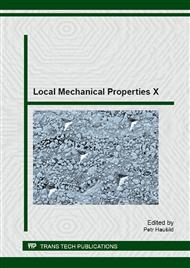p.197
p.201
p.205
p.209
p.213
p.217
p.221
p.225
p.229
Determination of Local Mechanical Properties of Si3N4 Based Foams
Abstract:
Local mechanical properties, particularly the hardness and Youngs modulus of highly porous silicon nitride based foams were studied in this work. Silicon nitride foams were prepared using polyurethane foam replication method to obtain appropriate cellular structure suitable for bio-application. Two types of the polyurethane foams were used (with average pore size 0.48 mm and 0.62 mm). Some of these samples were prepared by single or multiple infiltrations. The effects of structures, temperature of calcination, volume fraction of Si3N4 powder and number of the infiltrations on the local mechanical properties were investigated. The Youngs modulus of studied samples range from 12 to 46 GPa at the macroscopic scale measured by resonant frequency technique and from 10 to 28 GPa at the microscopic scale measured by instrumented indentation. Results showed increase of the hardness and Youngs modulus with increasing of the calcination temperature, with increasing of the number of infiltrations and also with increasing of volume fraction of Si3N4 powder in suspension. The results obtained from nanoindentation carry out lower values in comparison with the values measured by resonant frequency technique.
Info:
Periodical:
Pages:
213-216
Citation:
Online since:
March 2014
Keywords:
Price:
Сopyright:
© 2014 Trans Tech Publications Ltd. All Rights Reserved
Share:
Citation:


